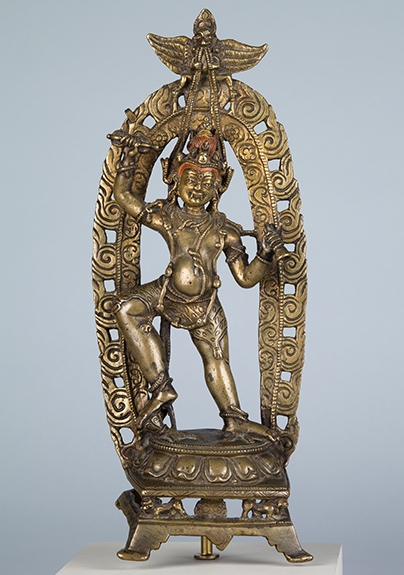
Vajrapani is the tantric deity who holds the vajra, the indestructible thunderbolt and short scepter, the implement of actively compassionate methods. The vajra is balanced by the bell, symbolizing the power of wisdom that is inseparable from it. Vajrapani’s attributes illustrate the connections between tantric ritual empowerments and political power, which appealed to rulers who adopted his worship. Vajrapani was one of the most popular deities in early Tantric Buddhism as it originated in India and spread elsewhere, and this bronze dates to the time of tantra’s early propagation in Tibet. According to Buddhist traditions, Vajrapani acts as a wrathful protector, but one who represents the potential of tantric practice for full awakening rather than just worldly benefits. He is often described as a general who commands the other protector deities and as the guardian of ritual secrets of tantra. The spells he guards are secret, and the esoteric system as a whole is known as mantra. State secrets are also known as mantra, and the king’s counsellors are known as mantrins. The vajra resembles the royal scepter, or danda, a symbolic weapon held by a ruler, general, or anyone who holds martial power.
One of the strongest connections between the tantric ritual of Vajrapani and kingship is the initiation or empowerment ceremony, abhisheka. This is a prerequisite for other tantric practices and is much like the coronation ceremony of a king, including symbolic actions like bathing with water and crowning. According to the story of Vajrapani’s original tantric initiation, the primordial Buddha Vairocana consecrated the 36 deities of his divine realm, or mandala, much as an emperor crowns his vassals. With the vajra placed in his hand Vajrapani was consecrated as the protector of the dharma and empowered to be a cakravartin, a victorious ruler who fights on behalf of all the buddhas. Following his empowerment, Vajrapani used his power to accomplish religious conversion by force. He overcome the Hindu god Maheshvara, or Shiva, and forced his retinue to surrender and support Buddhist teachings.
Come view our Art of the Week in the exhibition Masterworks of Himalayan Art
C2005.17.1, HAR 65566
- https://dev.rubinmuseum.org/images/content/7184/07.26.19_art_of_the_week_vajrapani_trampling_snakes__zoom.jpg
- https://dev.rubinmuseum.org/images/content/7184/07.26.19_art_of_the_week_vajrapani_trampling_snakes__zoom.jpg

